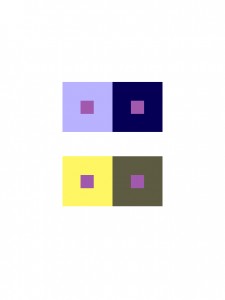Color Interaction Pairings
Problem: Create 8 paired interaction color studies. Try to make 1 color appear as 2 different colors by altering its surrounding/background color.
Limits: Using gouache, paint Josef Abers-style pairs. These consist of large squares 2″x2″ of a varying hues and small 1/2″x1/2″ center squares of one chosen hue. The small squares will sit in the middle of the large squares and should be the same for each pair.
Materials: Creative Process Book, pencils, Bristol Board 9×6″, gouache paints, brushes, palette, rags, water container, scissors, exacto knife, ruler/t-square, glue, misc. chosen materials.
Concepts: Simultaneous Contrast, After Images, Optical Mixing, Complementary Colors, Warm, Cool.
Technical Skills: painting techniques, draughmanship with ruler/t-square, exacto knife and collage.
Procedure:
Research / Inspiration
- Josef Albers was a student of the Bauhaus in Germany and color educator at the Black Mountain College and Yale. His experiments in color relationships are used throughout the world in the study of design and color.
- Use this tool to experiment with color interactions: http://www.jellocube.com/screendesign/simulcon.swf
Experimentation / Iteration
Create the following pairs. For specific instructions and references refer to the class outline links below.
- Each PAIR consists of 2 interactions. Completed studies will have a total of 4 interactions.
- 2 pairs of achromatic gray studies will explore interactions by shifting value.
- 2 pairs of color studies will explore interactions by shifting value (with color)
- 2 pairs of color studies will explore interactions by shifting hue, but not value.
- 2 pairs of color studies will explore interactions by shifting hue and value.
- Extra Credit: 2 pairs of color studies will attempt to make two different colors look as a like as possible.
- Each study should be properly mounted on clean 9×12″ bristol.
Expression of Form, Emotions, or Concepts
- Free-Study – Simultaneous Contrast
- Working in groups of 2 or 3, design a 14”x17” or larger composition that demonstrates the concepts we covered in our Color Interaction Studies.
- GOAL: Give a color at least two different identities throughout your compositions by exploring shifts in value, hue and temperature.
- Use your own forms of expression and experiment with process. The final composition can take any form or utilize any medium you choose.
- As with previous free-studies, research, thumbnails, color tests, consideration of overall compositional balance between figure and ground, unity, and communication of a clear concept or theme is important!
- Divide up the project responsibilities. Each member of the group must physically create some part of the final composition.
Thoughtful Assessment (verbal and written)
- Critique
- Bring all assignment parts to class, protected in a portfolio case or protective paper or cardboard envelope.
- Be prepared to present, discuss and analyze your finished work in terms of concept, craft, what you learned, and creative process.
- State the following: your name, what you are presenting (title and design problem), which parts are successful and why, which parts are unsuccessful and why
- Written Assessment
- In your Creative Process Book, at the end of the Assignment #4 section, document your thoughts about this project. Think about what you learned, what you could have done better (planning, material use, craft), and how you will apply what you learned to your next project.
Work Hour Tally
- In your Creative Process Book, outline the hours committed for each portion of the assignment, including dates and times.
